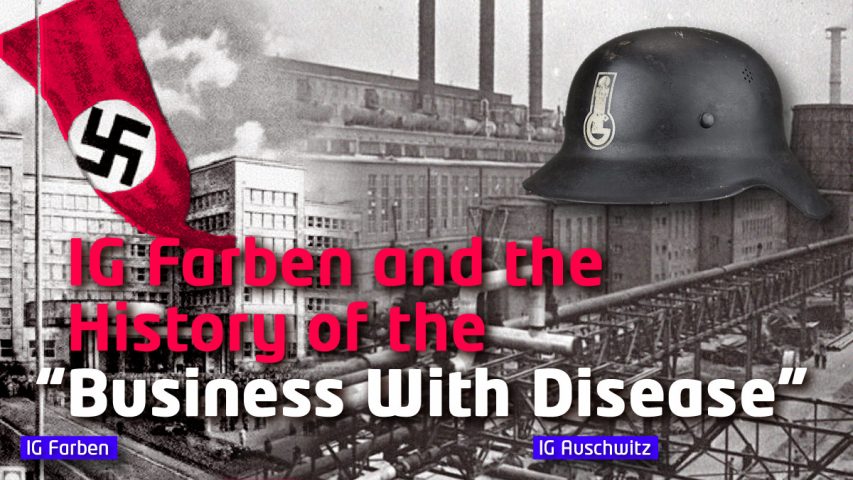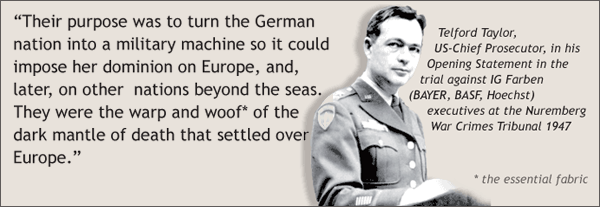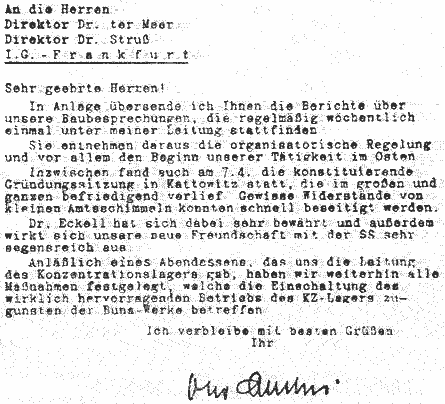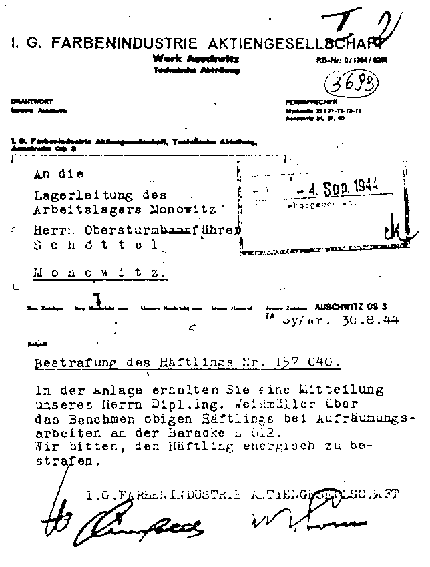- Have any questions? Contact us!
- info@dr-rath-foundation.org

The Investment ‘Business With Disease’
June 14, 2003
IG Фарбен и история «бизнеса на болезнях»
June 18, 2003IG Farben and the History of the “Business With Disease”


The most powerful German economic corporate emporium in the first half of this century was the Interessengemeinschaft Farben or IG Farben, for short. Interessengemeinschaft stands for “Association of Common Interests” and was nothing more than a powerful cartel of BASF, Bayer, Hoechst, and other German chemical and pharmaceutical companies. IG Farben was the single largest donor to the election campaign of Adolph Hitler. One year before Hitler seized power, IG Farben donated 400,000 marks to Hitler and his Nazi party. Accordingly, after Hitler’s seizure of power, IG Farben was the single largest profiteer of the German conquest of the world, the Second World War.
Zyklon-B, an extermination gas produced by Hoechst, was used to kill millions of innocent people, before their corpses were burnt
One hundred percent of all explosives and of all synthetic gasoline came from the factories of IG Farben. Whenever the German Wehrmacht conquered another country, IG Farben followed, systematically taking over the industries of those countries. Through this close collaboration with Hitler’s Wehrmacht, IG Farben participated in the plunder of Austria, Czechoslovakia, Poland, Norway, Holland, Belgium, France and all other countries conquered by the Nazis.
The U.S. government’s investigation of all the factors leading to the Second World War in 1946 came to the conclusion that without IG Farben the Second World War would simply not have been possible. We have to come to grips with the fact that it was not the psychopath, Adolph Hitler, or bad genes of the German people that brought about the Second World War. Economic greed by companies like Bayer, BASF and Hoechst was the key factor in bringing about the Holocaust.
No one who saw Steven Spielberg’s film “Schindler’s List” will forget the scenes in the Auschwitz concentration camp.
The Birth of IG Farben and the Support for Hitler
(from the book “Sword And Swastika” by Telford Taylor)
After the First World War, all the major chemical concerns were merged into a single gigantic trust in 1926 – the I.G. Farbenindustrie A.G. – under the leadership of Carl Duisberg and Carl Bosch. Dyestuffs, pharmaceuticals, photographic supplies, explosives, and a myriad of other products poured forth in ever-growing volume and variety.
Soon after the election of July, 1932, in which the Nazis had doubled their vote, Heinrich Buetefisch [chief of the I.G. Farben – Leuna plant] and Heinrich Gattineau [a Farben official who was also an SA officer and personally known to both Rudolf Hess and Ernst Roehm]. waited upon the Fuehrer-to-be to learn whether Farben could count on governmental support for its synthetic gasoline program in the event the Nazis should attain power. Hitler readily agreed that Farben should be given the necessary support to warrant expansion of the Leuna plant.
After the seizure of power, Farben lost no time following up this auspicious introduction. Significantly, Farben’s chosen channel was not the ‘Heeresleitung’ but Hermann Goering’s new Air Ministry. In a long letter to Goering’s deputy Erhard Milch, Carl Krauch of Farben outlined a “four-year plan” for the expansion of synthetic fuel output. Thereupon, Milch called in Generalleutnant von Vollard Bockelberg, Chief of the Army Ordnance Office, and it was agreed that the Army and the Air Ministry would together sponsor the Krauch project. A few months later Farben received a formal Reich contract calling for the enlargement of Leuna so that production would reach three hundred thousand tons per year by 1937, with Farben’s sales guaranteed for ten years – until June 30, 1944 – on a cost-plus basis.

1941: I.G. Farben’s “friendship” with the SS helps to increase the speed of construction of Auschwitz-Buna against the resistance “of some little bureaucrats”. A letter from Dr. Otto Ambros to the Director of I.G. Farben Frankfurt, Fritz ter Meer
I.G. Farben and the Auschwitz Concentration Camp
Auschwitz was the largest mass extermination factory in human history, but the concentration camp was only an appendix.
The main project was IG Auschwitz, a 100% subsidiary of IG Farben, the largest industrial complex of the world for manufacturing synthetic gasoline and rubber for the conquest of Europe.
On April 14, 1941 , in Ludwigshafen , Otto Armbrust, the IG Farben board member responsible for the Auschwitz project, stated to his IG Farben board colleagues, “our new friendship with the SS is a blessing. We have determined all measures integrating the concentration camps to benefit our company.”
The pharmaceutical departments of the IG Farben cartel used the victims of the concentration camps in their own way: thousands of them died during human experiments such as the testing of new and unknown vaccines.
The map of Auschwitz (above) speaks for itself. The size of the IG Auschwitz plant (red area) was larger than all Auschwitz concentration camps (blue area) taken together.
There was no retirement plan for the prisoners of IG Auschwitz. Those who were too weak or too sick to work were selected at the main gate of the IG Auschwitz factory and sent to the gas chambers. Even the chemical gas Zyklon-B used for the annihilation of millions of people was derived from the drawing boards and factories of IG Farben.
Medical Experiments in Auschwitz Conducted by I.G. Farben
(from the book “I.G. Farben – from Anilin to forced labor” by Jörg Hunger and Paul Sander)
Scientific experiments were also done in other concentration camps. A decisive fact is that IG employee SS major Dr. med. Helmuth Vetter, stationed in several concentration camps, participated in these experiments by order of Bayer Leverkusen.
At the same time as Dr. Joseph Mengele, experimented in Auschwitz with medications that were designated “B-1012″, B-1034”, “3382” or “Rutenol”. The test preparations were not only applied to those prisoners who were ill, but also to healthy ones. These people were first infected on purpose through pills, powdered substances, injections or enemas. Many of the medications caused the victims to vomit or have bloody diarrhoea. In most cases the prisoners died as a result of the experiments.
In the Auschwitz files correspondence was discovered between the camp commander and Bayer Leverkusen. It dealt with the sale of 150 female prisoners for experimental purposes: “With a view to the planned experiments with a new sleep-inducing drug we would appreciate it if you could place a number of prisoners at our disposal (…)” – “We confirm your response, but consider the price of 200 RM per woman to be too high. We propose to pay no more than 170 RM per woman. If this is acceptable to you, the women will be placed in our possession. We need some 150 women (…)” – “We confirm your approval of the agreement. Please prepare for us 150 women in the best health possible (…)” – “Received the order for 150 women. Despite their macerated condition they were considered satisfactory. We will keep you informed of the developments regarding the experiments (…)” – “The experiments were performed. All test persons died. We will contact you shortly about a new shipment (…)”
A former Auschwitz prisoner testified: “There was a large ward of tuberculars on block 20. The Bayer Company sent medications in unmarked and unnamed ampoules. The tuberculars were injected with this. These unfortunate people were never killed in the gas chambers. One only had to wait for them to die, which did not take long (…) 150 Jewish women that had been bought from the camp attendant by Bayer, (…) served for experiments with unknown hormonal preparations.”
Parallel to the tests by Behringwerke and Bayer Leverkusen the chemical-pharmaceutical and serologic-bacteriological department at Hoechst started experimenting on Auschwitz prisoners with their new typhus fever preparation “3582”. The first series of tests had results that were far from satisfactory. Of the 50 test persons 15 died; the typhus fever drug led to vomiting and exhaustion. Part of the Auschwitz concentration camp was quarantined, which led to an extension of the tests to the concentration camp in Buchenwald . In the journal of the “Department for typhus fever and viral research of the concentration camp Buchenwald” we find on January 10th, 1943: “As suggested by the IG Farbenindustrie A.G. the following were tested as typhus fever medications: a) preparation 3582 <Akridin> of the chem. pharm. and sero-bact. Department Hoechst – Prof. Lautenschläger and Dr. Weber – (therapeutic test A), b) methylene blue, formerly tested on mice by Prof. Kiekuth, Elberfeld (therapeutic test M).”
The first and also the second series of therapeutic tests, held in Buchenwald between March 31st and April 11th 1943 , were negative due to insufficient contamination of the tested prisoners. Neither did the experiments in Auschwitz show evident successes.
The scientific value of all these experiments, whether ordered by the IG Farben or not, was in fact zero. The test persons were in bad physical condition, caused by forced labor, insufficient and wrong nutrition and diseases in the concentration camp. In addition to this there were generally bad sanitary circumstances in the laboratories. “The test results in the concentration camps, as the IG laboratory specialists should have known, could not be compared to results made under normal circumstances”.
The SS physician Dr. Hoven testified to this during the Nuremberg Trial: “It should be generally known, and especially in German scientific circles, that the SS did not have notable scientists at its disposal. It is clear that the experiments in the concentration camps with IG preparations only took place in the interests of the IG, which strived with all means to determine the effectiveness of these preparations. They let the SS deal with the – shall I say – dirty work in the concentration camps. It was not the IG’s intention to make any of this public, but rather to put up a smoke screen around the experiments so that (…) they could keep any profits to themselves. Not the SS but the IG took the initiative for the concentration camp experiments.”

A letter from 1944 in which I.G. Farben orders an “harsh punishment” for a slave laborer in Auschwitz-Monowitz.
Continue reading on page 2



